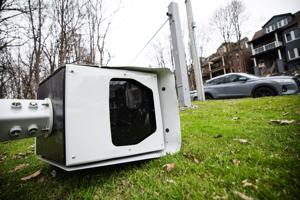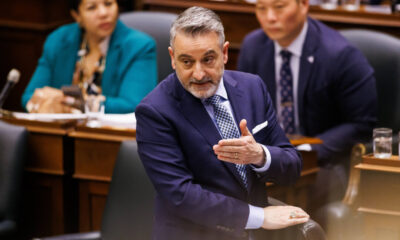Science
Toronto Hospital Launches Remote Robotic Stroke Treatment

A team at St. Michael’s Hospital in Toronto has made a significant advancement in stroke treatment by successfully completing ten brain angiograms using a robot controlled remotely by a neurosurgeon. This groundbreaking approach aims to provide essential stroke care to patients in northern Ontario, where access to specialized medical services can be limited.
A brain angiogram, typically a minimally invasive procedure, involves placing a catheter in the femoral artery through the groin and guiding it to the brain to inject contrast dye. This allows doctors to visualize issues within blood vessels via X-ray. Traditionally, the neurosurgeon is present in the operating room, manually maneuvering the catheter. In a pioneering effort, Dr. Vitor Mendes Pereira, head of the neurovascular program at St. Michael’s, utilized a computer to control a robot that performed these procedures remotely.
Over the course of the procedures, the distance between Dr. Pereira and the robot increased steadily, starting from across the room, then from another room in the hospital, and finally from St. Joseph’s Health Centre, located approximately six kilometres away. The connection between the computer and the robot was facilitated by a high-speed fibre optic internet link, which Pereira described as “incredibly fast.” He noted, “I didn’t see any difference on being here in this (operating) room, in the same building or being in another hospital in terms of visualization and also on the surgical experience.”
The next phase of this initiative involves extending the distance between Dr. Pereira and the robot to over 600 kilometres, which is the distance from Toronto to the Sault Area Hospital in Sault Ste. Marie, Ontario. Following additional diagnostic angiograms, the team plans to seek approval from Health Canada to initiate a clinical trial using this robotic technology for performing endovascular thrombectomies on stroke patients. This procedure employs a stent to capture and eliminate blood clots causing strokes.
Currently, the Sault Area Hospital lacks personnel to perform endovascular thrombectomies (EVTs), compelling stroke patients to be transferred to the nearest stroke centre in Sudbury, Ontario. This transfer can take between one hour by air ambulance and three and a half hours by road, often with considerable wait times for the air ambulance. Dr. Laura Stone, medical director of the emergency department at Sault Area Hospital, emphasized the urgency of timely treatment. She stated, “Every delay in getting treatment after a stroke translates into more neurons dying, which means more disability — or death — for the patient. Time is brain.”
The potential implementation of this robotic system at Sault Area Hospital could change the landscape of stroke treatment in the region. With the robot readily available, the EVT could be conducted on-site, while Dr. Pereira manages the procedure from his computer in Toronto. The St. Michael’s team, led by research program manager and technologist Nicole Cancelliere, will provide training for Sault Area Hospital staff on how to set up the robot and insert the catheter.
Dr. Michael Kutryk, an interventional cardiologist and researcher at St. Michael’s Hospital who also heads cardiology at Sault Area Hospital, has been instrumental in fostering collaboration between the two healthcare facilities. He highlighted the life-saving potential of this technology, stating, “It’s going to be the difference between somebody being paralyzed and dysarthric — not able to speak — compared to somebody walking out of the hospital two or three days later.”
Dr. Kutryk anticipates that the robot-assisted EVTs could be operational at the Sault Area Hospital by late next year or early 2027. He remarked, “This is kind of a perfect thing to do for a robot because it’s so safe in human hands; there’s very little that can go haywire.”
One of the primary concerns is the reliability of the internet connection between the robot and the surgeon. Dr. Pereira assured that the connection is rigorously tested and that a backup connection would always be available. If there were any delays in the robot’s response, the medical team would revert to standard stroke care procedures, ensuring patient safety.
Given that Sault Area Hospital sees only about 12 to 15 patients annually needing EVTs, hiring a dedicated neurovascular specialist to be on standby is not feasible. Yet, the introduction of robotic technology is expected to provide “groundbreaking” advancements in care, according to Dr. Stone. “We’re increasing the speed at which these patients receive this life-saving procedure,” she stated.
Although Sault Ste. Marie has been selected as the pilot hospital for this project, the St. Michael’s team hopes that their clinical research will benefit patients in other remote regions. Dr. Kutryk expressed optimism about the future of this technology, likening it to a “little bit of ‘Star Wars’,” and believes it will soon become a reality in hospitals worldwide.
The robotic system used for the brain angiograms was developed by Remedy Robotics, a private company based in San Francisco specializing in cardiovascular interventions. This innovative approach represents a significant leap forward in remote healthcare delivery, particularly for those in underserved areas.
-

 Politics1 week ago
Politics1 week agoSecwepemc First Nation Seeks Aboriginal Title Over Kamloops Area
-

 World4 months ago
World4 months agoScientists Unearth Ancient Antarctic Ice to Unlock Climate Secrets
-

 Entertainment4 months ago
Entertainment4 months agoTrump and McCormick to Announce $70 Billion Energy Investments
-

 Lifestyle4 months ago
Lifestyle4 months agoTransLink Launches Food Truck Program to Boost Revenue in Vancouver
-

 Science4 months ago
Science4 months agoFour Astronauts Return to Earth After International Space Station Mission
-

 Technology3 months ago
Technology3 months agoApple Notes Enhances Functionality with Markdown Support in macOS 26
-

 Top Stories1 month ago
Top Stories1 month agoUrgent Update: Fatal Crash on Highway 99 Claims Life of Pitt Meadows Man
-

 Sports4 months ago
Sports4 months agoSearch Underway for Missing Hunter Amid Hokkaido Bear Emergency
-

 Politics3 months ago
Politics3 months agoUkrainian Tennis Star Elina Svitolina Faces Death Threats Online
-

 Politics4 months ago
Politics4 months agoCarney Engages First Nations Leaders at Development Law Summit
-

 Technology4 months ago
Technology4 months agoFrosthaven Launches Early Access on July 31, 2025
-

 Top Stories3 weeks ago
Top Stories3 weeks agoFamily Remembers Beverley Rowbotham 25 Years After Murder




















